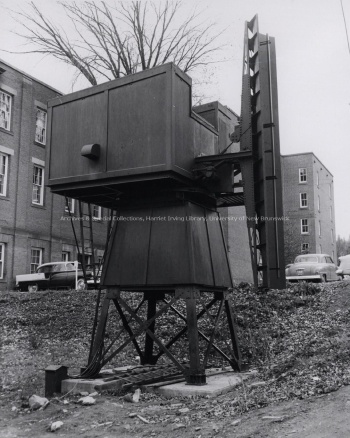The outbreak of the Second World War in 1939 signalled significant changes for UNB as a whole, with numerous male students enlisting throughout the war and the entirety of the female student population occupied with aiding the war effort. Two women in particular took up the call to arms; Barbara and Margaret White, identical twin sisters, became the first co-eds in the class of 1943 to join the Armed Forces, enlisting in the Women's Division of the Royal Canadian Air Force. The White sisters left UNB in the winter of 1943 before completing their year, but they were able to return to Fredericton and receive their degrees in May. The twins garnered a great deal of attention at Encaenia when they attended wearing their "Air Force Blue" uniforms.
UNB women students helped the war effort by knitting for the soldiers and organizing teas and dances to raise money for the Red Cross, though students activities at the university were generally curtailed. The Junior Tea, an elaborate social event at UNB that was traditionally held in the spring and organized by the junior women in honour of the senior women was cancelled in 1941 due to the war because the women decided to focus on the war effort. This decision was an unpopular one, with the junior class ostracized for a time, but the women felt the Tea to be "frivolous" during a time of war.
All women students were also expected to participate in a war service program. This included three hours a week of physical training and drill as well as lectures and courses in first-aid. In 1943, UNB became the first university in the Maritimes to establish a unit of the Canadian Red Cross Corps (CRCC). The CRCC unit was intended to train college women to be a "disciplined body of women workers" for the Red Cross. Despite an initial excitement over the program, the UNB Corps was soon disbanded as its members decided it would be more useful to volunteer at the Blood Processing Laboratory or to produce demanded materials such as bandages, as the lectures and drill were reportedly viewed to have little practical benefit. A contributing factor to the women's dissatisfaction with the CRCC was the issue of uniforms; while their male counterparts received free uniforms, the women were expected to pay for theirs, which cost approximately ten dollars at the time. As many of the women could not afford this extra expense, they wore white armbands adorned with a red cross.
A number of war-time student groups formed, engaging in various activities intended to help in the war effort. The War Effort Committee collected funds through several means, donating these funds to the war effort. The War Savings Stamps Committee had students pledge to buy stamps from them throughout the school year, the proceeds of which were donated to the war effort.
The Second World War also saw a number of military contingents hosted at UNB.
The Canadian Officers Training Corps saw its highest enrolment since the First World War, while the University Air Training Corps, and University Naval Training Division were both formed during this era.
Once the war had ended, UNB saw its highest enrolment ever as 326 veterans brought the total count of students to over 700. The provision of accommodations for these students was accomplished by housing them at Alexander College; another 175 students enrolled in January of 1946.
Source(s):
- The Brunswickan, vo. 63, no. 18, 3 March 1944, p. 3.
- The Brunswickan, vol. 60, no. 6, 1 November 1940.
- The Brunswickan, vol. 62, no. 5, 23 October 1942.
- The Brunswickan, vol. 62, no. 17, 26 February 1943.
- The Brunswickan, vol. 63, no. 3, 15 October 1943.
- The Brunswickan, vol. 65, no. 1, 4 October 1945.
- The Brunswickan, vol. 65, no. 10, 17 January 1946.
- Up the Hill, 1940-42.
- Senate Minutes (UA RG 40), Book 5 (1927-1943), p. 227, 245, 272.
- Montague, Susan. A Pictorial History of the University of New Brunswick. Fredericton: University of New Brunswick, 1992, p. 87.
- Main Page
- Anniversaries
- Brief History of UNB
- Buildings
- Faculties and Departments
- Governance and Administrative Positions
- Lecture Series
- Official University Events and Symbols
- People of UNB
- Plaques, Monuments and Structures
- Prizes and Awards
- Sports and Athletics
- Student Clubs and Societies
- Student Events and Escapades
- University Publications
- Women's Sports at UNB
- About UNB Archives and Special Collections
Request an Appointment
Prior arrangements must be made for the retrieval of this material. Please email archives@unb.ca to make an appointment.
Procedures
Help Desk Hours
- Monday - Friday
- 10:00 am - 12:00 pm
- 1:00 pm - 4:00 pm
Contact Us
- 5th Floor, Harriet Irving Library
- University of New Brunswick
- 5 Macaulay Lane, Box 7500
- Fredericton, NB E3B 5H5 Canada
- archives@unb.ca
- Staff Directory
